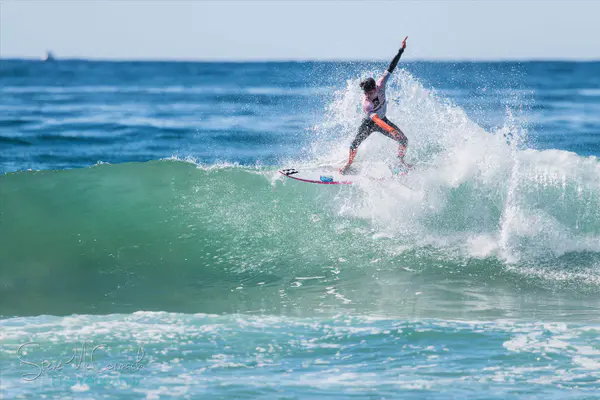Lola is a term used in surfing to describe a specific surf forecast model. Surfline, a popular surf forecasting service, developed Lola. The name stands for “LOng-range swells ALert.” Lola provides surfers with accurate and reliable information about upcoming swells, helping them plan their surf sessions effectively.
How Does Lola Work?
Lola analyzes data from various sources, such as weather stations and satellites. It processes this data to predict wave conditions. Lola considers factors like wind speed, wind direction, and swell period. These elements are crucial in determining the size and quality of waves.
The Importance of Swell Period
The swell period is the time between wave crests. A longer swell period usually means more powerful waves. Lola helps surfers by predicting swell periods accurately. This allows surfers to choose the best times to hit the waves.
Wind Speed and Direction
Wind plays a significant role in wave formation. Offshore winds can create clean, well-formed waves. Onshore winds, however, can make the waves choppy and less enjoyable. Lola’s forecasts include wind speed and direction, giving surfers a complete picture of what to expect.
Data Sources for Lola
Lola uses data from buoys, weather stations, and satellites. Buoys in the ocean measure wave height, period, and direction. Weather stations provide information on wind and atmospheric conditions. Satellites offer a broad view of weather patterns and ocean conditions.
How Surfers Use Lola
Surfers rely on Lola for planning their surf sessions. They check the forecasts to find the best spots and times for surfing. Lola’s detailed reports help surfers avoid poor conditions and find the best waves.
Accuracy of Lola
Lola is known for its accuracy. Surfline continuously updates and improves the model. Feedback from surfers helps fine-tune the predictions. This makes Lola a trusted tool in the surfing community.
Comparing Lola to Other Models
There are other surf forecasting models, but Lola stands out. Its long-range forecasts are particularly useful. While other models may focus on short-term predictions, Lola provides a broader view. This helps surfers plan trips and sessions days or even weeks in advance.
The Evolution of Surf Forecasting
Surf forecasting has come a long way. In the past, surfers relied on local knowledge and simple weather charts. Today, advanced models like Lola offer detailed and accurate predictions. This evolution has made surfing more accessible and enjoyable.
How to Access Lola
Lola forecasts are available on Surfline’s website and app. Users can view detailed reports for various surf spots. The platform also offers premium features for more in-depth analysis.
Benefits of Using Lola
Using Lola has several benefits for surfers:
- Planning: Surfers can plan their sessions around the best conditions.
- Safety: Accurate forecasts help surfers avoid dangerous conditions.
- Travel: Surfers traveling to new spots can use Lola to find the best waves.
Lola and Surf Competitions
Lola is also used in surf competitions. Organizers rely on accurate forecasts to schedule events. This ensures that competitions take place in optimal conditions, providing a better experience for both surfers and spectators.
See Also: What Is a Kook in Surfing Terms
User Feedback and Community Involvement
Surfline encourages user feedback to improve Lola. Surfers can report their experiences, helping to refine the model. This community involvement is key to Lola’s success and accuracy.
Challenges and Future in Surf Forecasting
Despite advancements, surf forecasting faces challenges. Ocean conditions can be unpredictable. Rapid changes in weather patterns can affect accuracy. However, models like Lola continue to improve, offering reliable forecasts.The future of surf forecasting looks promising. With ongoing technological advancements, models will become even more accurate. Machine learning and AI could play a significant role in refining predictions.
Conclusion
In summary, Lola is a term used in surfing to describe smaller, slower-moving waves that are ideal for beginners or those looking for a more relaxed surfing experience. These waves are often found in protected coves or bays, where the water is calmer and the waves are less powerful. While they may not offer the same thrills as larger waves, Lola waves still provide a unique and enjoyable surfing experience that requires different techniques and skills.These waves are often found in protected coves or bays and require different techniques and skills than larger, more powerful waves. While they may not offer the same thrills as other types of waves, Lola waves still provide a unique and enjoyable surfing experience that can be appreciated by surfers of all levels.
FAQ: What is Lola in Surfing?
Q: What is Lola in surfing?
A: Lola is a type of surfboard that is shorter and wider than traditional longboards. It is designed for smaller waves and is often used by beginners or those who want to practice their maneuvers in the whitewater.
Q: How does a Lola differ from a traditional longboard?
A: A Lola is generally shorter and wider than a traditional longboard, making it more stable and easier to control in smaller waves. It also has a flatter rocker, which allows for better maneuverability in the whitewater.
Q: Who is a Lola board suitable for?
A: A Lola board is suitable for beginners or those who want to practice their maneuvers in the whitewater. It is also a good option for those who want a more stable board for smaller waves.
Q: Can you perform tricks on a Lola board?
A: Yes, you can perform tricks on a Lola board. However, due to its stability and design, it may not be as conducive to performing high-flying aerials or aggressive maneuvers as a traditional longboard or shortboard.
Q: Is a Lola board suitable for experienced surfers?
A: While a Lola board may not be the first choice for experienced surfers looking to ride big waves or perform advanced maneuvers, it can still be a fun and useful board to have in your quiver for smaller days or for practicing in the whitewater.

